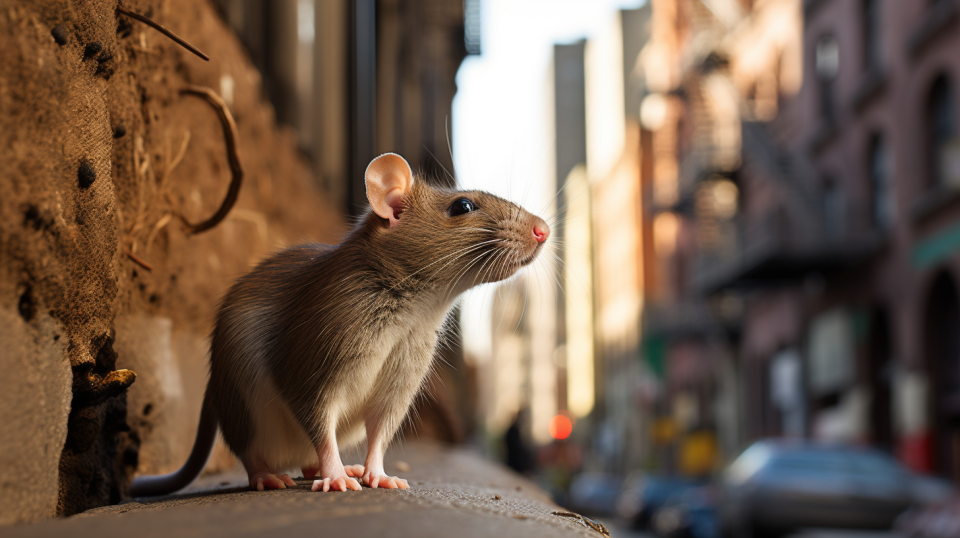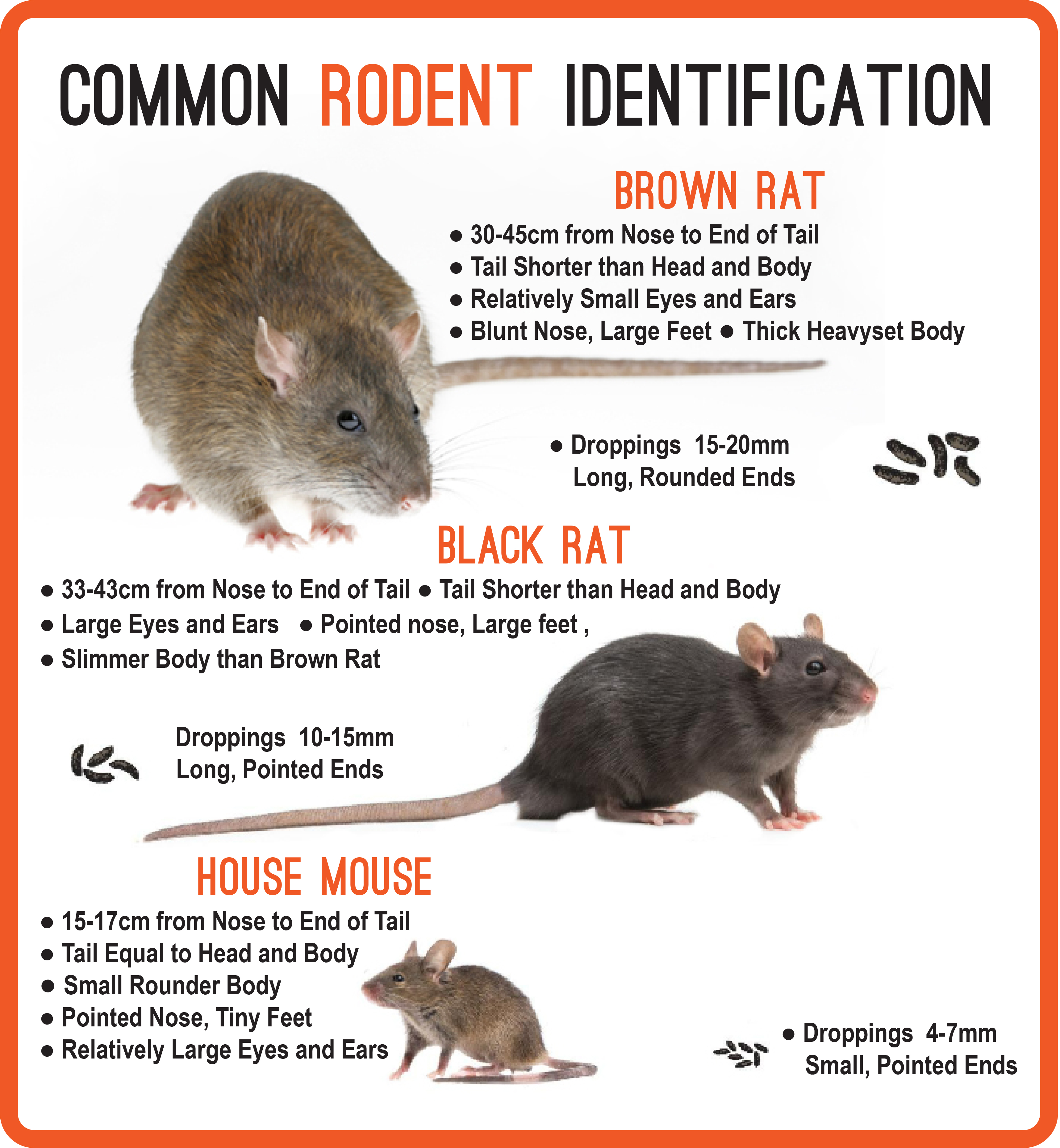
Rat identification is important in understanding their presence, behaviour, and potential damage they can cause is paramount in effective pest management.
Rat species are highly adaptable, though often hidden from sight, and can have a significant impact on our surroundings.
In this comprehensive guide, we delve into the world of rat identification, focusing on the two most prevalent species: the Brown Rat and the Black Rat.
We'll also explore the common signs of rat infestations and the damage they leave in their wake.

Table Of Contents:
- Rat Identification
- Rat Identification: Brown Rat vs The Black Rat
- Pet Rats
- Common Rat Damage
- Preventing Rat Infestations
- Signs of a Rat Infestation
-
Rat Identification Frequently Asked Questions
- What is the most common rat in Australia?
- How do you tell the difference between rat and mouse droppings in Australia?
- What is the difference between a mouse and a rat in Australia?
- What are Australian rats called?
- What is Rat slang for?
- Which Australian marsupial looks like a rat?
- Are rats harmful to humans?
- Conclusion
Rat Identification
In Australia, there are native and introduced rat species; Native Bush Rats, Water Rats and Swamp Rats are protected, which means you can't harm them.
The two common introduced rats are Brown Rats and Black Rats. Native bush rats have a tail shorter than their body length; bush rats vary in size and colouration, measuring 100 to 205 mm with a tail length of 100 to 195 mm.
It weighs an average of 125 grams and exhibits greyish or reddish-brown fur. round ears, and pink foot pads.
The bush rat has a distinct diet from other local rodents. In summer, it mainly eats fruit, arthropods, and seeds. In winter, it relies heavily on a specific type of cyperaceous plant.
When in the forest, it primarily feeds on fungi and fibrous plant material. Additionally, bush rats consume nectar without harming the blossoms, potentially assisting in pollination.
The Australian swamp rat is about 160 mm long, with a tail of 110 mm and weighs around 120 grams. It has a stout build, black-brown fur, and dark feet.
The underside is cream to brown, and it has small, mostly hidden ears. Its tail is dark grey, scaly, and sparsely furred. The swamp rat diet is plant-based, including reeds, seeds, and swamp grass stems.
In summer, they also eat more insects and fungi. In spring, seeds become a major part of their diet, likely due to their availability and benefits for breeding
Because of their shy natures and differing diets that are mainly vegetation, insects and fungi, the native rats are less likely to be near human dwellings and are less inclined to be attracted to rat baits
Rat Identification: Brown Rat vs The Black Rat
The Brown rat, scientifically named Rattus norvegicus, goes by various aliases, including street rat, sewer rat, wharf rat, Hanover rat, Norway rat, and Norwegian rat, and is typically grey-brown with a long tail and large ears.
They have blunt noses and are usually about 20cm long – not including the tail. But size isn’t everything; behaviour also plays a big part in identification.
Black rats, also known as ship rats or roof rats due to their preference for high places, differ slightly in appearance from brown ones. They're smaller (about 16cm), and have pointy noses and larger ears compared to body size.
But don't let appearances fool you: both species cause similar problems when they reside on your property.

Pet Rats
As long as they are contained, pet rats are truly delightful companions. Their charming personalities, inquisitive nature, and boundless energy make them wonderful additions to any household. These small, furry friends are not only highly intelligent but also incredibly affectionate, forming strong bonds with their human caregivers.
Watching them play and explore their surroundings is a joy in itself, and their gentle nature makes them perfect for cuddling and interacting with. Whether they're performing acrobatics, snuggling up for a nap, or nibbling on a treat, pet rats have a special way of brightening your day and bringing warmth and laughter to your life.
Common Rat Damage
Rats can be more than a mere annoyance; they can inflict serious damage to your possessions. From rats building nests to gnawing on structures and electrical wires to spreading diseases through their urine and droppings, rats present various threats.
Structural harm is often the most visible form of rat damage. Rats have strong teeth, which let them chew through wood or plastic.
Their need to continuously chew doesn't stop there. Rats also enjoy chewing on electric cables. This habit poses a significant fire risk.
Beyond physical destruction, another major concern is disease transmission because rats can carry harmful pathogens in their droppings and urine, emphasising why it's so crucial we control rat populations effectively.
Preventing Rat Infestations
It is important to eliminate as many things that attract rats as possible to ensure effective rodent control;
- Frequent Cleaning. Ensure all rubbish bins are securely fastened, and food is not left in the open. This means sealing up any rubbish bins and not leaving food out overnight.
- Maintain a clean environment. It is crucial because untidiness attracts rats. So, give that neglected garden shed a good clear-out. The less clutter they have to hide in, the better.
- Solid Barriers: Fine metal mesh can prevent rodents from entering through small openings.
To stop an infestation before it starts takes effort and vigilance - but remember: prevention is not always enough. You may need to enlist the help of a professional to install bait strategies.
DIY Rat Rid
If you feel comfortable placing the rat bait stations yourself, you can purchase the professional grade bait and bait stations from diyratrid.com.au; they also have a handy free measuring tool so you know how many bait stations you will need for your building.
Related
Signs of a Rat Infestation
Rat identification starts with evidence they are in the area. You could see one or more of these tell tale signs;
- Gnaw marks, especially on food packaging or the structure of your property, can be clear indicators. You might also notice smudge marks as rats often leave dirty tracks along walls and floorboards.
- Droppings. Rats produce up to 40 droppings per night, and they're usually found in concentrated areas.
- Urine trails and smell. Rats are always urinating either as defecation or to communicate with other rats.
- Noises. Rats are nocturnal, so you'll likely hear scratching noises at night from roof crawl spaces, cavity walls or under floorboards.
If you spot these signs but aren't sure if it's a rat issue, ask for professional advice immediately - time is crucial. The faster we act to remove them, the better, preventing more damage and reducing health risks.

Rat Identification Frequently Asked Questions
What is the most common rat in Australia?
The Brown Rat, also known as the Norway Rat, is the most widespread rat species in Australia, closely followed by Black rats also known as Roof Rats.
How do you tell the difference between rat and mouse droppings in Australia?
Rat droppings are considerably bigger, ranging between 15-20mm, long with rounded ends for Brown Rats and 10-15mm, long with pointed ends for Black Rats, whereas mouse droppings are 4-7mm, small with pointed ends.
What is the difference between a mouse and a rat in Australia?
Mainly the size; a mouse is only 15-17cm, including the tail, while a Norway rat is 30-45cm, including its rats tail and has small ears and a blunt nose compared to a mouse with large ears and a pointed nose.
What are Australian rats called?
Bush Rats or Swamp Rats
What is Rat slang for?
In slang, 'Rat' often refers to someone who betrays or snitches on others. It's not typically used positively.
Which Australian marsupial looks like a rat?
The Bandicoot has many physical traits similar to rats but don't be fooled - it's an Aussie marsupial.
Are rats harmful to humans?
Rats can indeed pose harm by spreading diseases and causing property damage. That said, not all encounters with rats are dangerous.
Conclusion
Rat identification between rat species, particularly the Brown Rat and the Black Rat, is crucial for effective pest management.
Understanding the potential damage they can inflict on our surroundings enables us to take proactive measures.
By implementing comprehensive prevention strategies and remaining vigilant for early signs of infestations, we can protect our homes against these unwanted intruders.
Remember, swift action is key in reducing rat-related issues and maintaining a healthy, pest-free environment.

More Possum articles you may like:
- Possum: Proven Deterrent and Removal Methods.
- Possum Deterrents vs Repellents: What's Effective?
- Dead Possum Dilemma: Removal and Prevention.
- Gutter Guard & Valley Guard Solutions for Possum Prevention.
- Tree Guard: The Essential Guide.
- Possum Box Installation: A Guide to Suitable Habitats.
- Possum Noises: A Guide to Species Identification.
- What Do Possums Eat and Possum Poop: Identifying Factors.
- Possum Removal: How to Get Rid of Possums Permanently.
- Possum Removalists: How to Choose the Right Expert.
- Possum Trap: Essential Do’s and Don’ts for Success.
- Catch and Release Licences: How to Remove Possums Legally.


